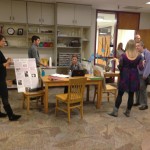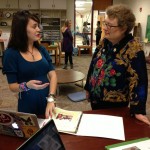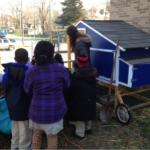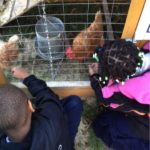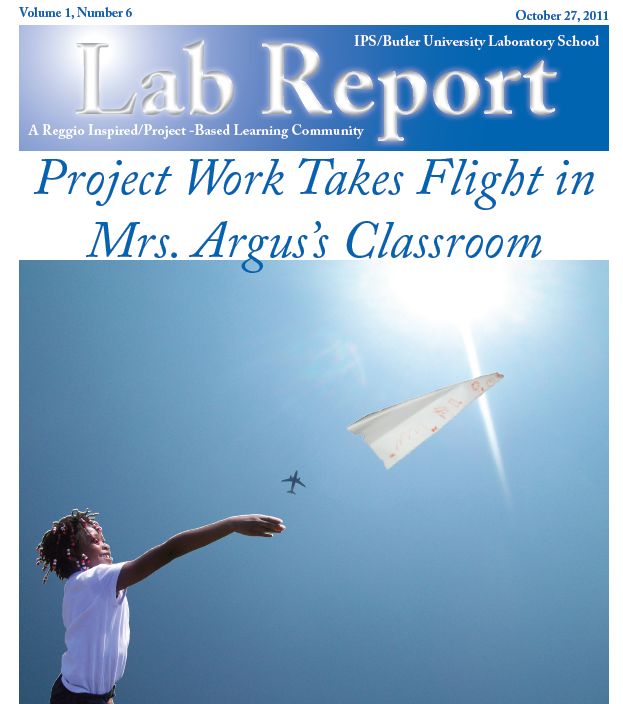Dec
05
2012

Ms. Hargrove
On Monday, December 3rd, the Block A students shared their final Teacher Research Projects. The teacher research project was a hands-on way for the Block A students to experience classroom life. Butler professors, Lab School faculty, friends, and family were all invited to attend this event. This event was the culmination of a semester’s work of research. Each student had the opportunity to showcase his/her accomplishments from the semester. We spent ten weeks in the classrooms collecting data and observing our students to try to answer our questions.
Throughout the course of the semester, we had to complete a variety of tasks as teachers in the classroom. These included: read alouds, conferencing, small group instruction, and a math/literature lesson. When we first started administering these tasks, questions started to form. Each Block A student came up with a different and thought-provoking question. These questions were unique to individual classrooms and focused on our own educational philosophies.
A lot of time and effort was put into the Teacher Research Projects, and the end results really showed it. We are very proud of our fellow classmates and friends. These projects were completed with professionalism and presented with confidence. We can not wait to see what Block B has in store!
Written by: Kara Saks, Sam Karmia, and Sara McDonald
Nov
29
2012

Ms. Hargrove
All Cooped Up: Since the spring, the Butler Lab School 60 has been engaging their students with a chicken coop! The chickens are laying eggs in the chicken coop and the students have opportunities to observe and watch. The classes alternate week by week and each get to feed and give water to the chickens. This week Miss Cegielski’s class fed the chickens and found one egg on Wednesday.
Lately Miss Cegielski’s students have shown interest in Abraham Lincoln and the issue of slavery in the past. Miss Cegielski has been displaying books and asking the students questions which has led to incredible conversation in the class! The students are incredibly interested about this topic and have treated the issue very respectfully.
-Carly Plumlee
Update from the Butler classroom: Outside of the classroom, we have been working hard on completing our Teacher Research Reports. Throughout the entire semester, some of our work has been centered around a question we came up with at the start of the semester. As we have compiled data and implemented interventions with the children, we have accumulated loads of work to help us with our findings. We are currently in the process of putting all of this data in to one place, the Teacher Research Binder. In this will include our question, context (data about the school, classroom, focal child), information on our question, our interventions (work completed with focal child), findings, and conclusions. While completing this report and looking back at the past few months, it has been extremely enlightening, and has made the entire semester of work seem extremely worthwhile. It has been a joy to work with the kids at the Lab School, and we have learned as much from the kids as they have from us.
-Bo Davidson
Dreams Come True: I (Maggie) am placed in the preschool classroom at School 60, also known as St. Mary’s. My favorite thing about St. Mary’s is that the students direct their own learning and the teachers administer it. One way I can example this was when Mae, a three year old, came into class talking about a dream she had the night before. She said that she woke up in the middle of the night because she was painting leaves in her dream. She was fascinated by this and could not stop talking about this. Ms. Fogler, the head teacher, asked Mae if she would like to paint leaves and other parts of nature in class. Of course, Mae and all the other students were more than excited for this activity! They all went outside and picked up leaves, sticks, branches, etc. and then painted them in the classroom. This is a perfect example of how students direct the classroom, but the teacher administers it. It is the teacher’s job to find things that the students are interested and put them in a project.
-Maggie Harbison
Nov
15
2012

Ms. Hargrove
On Monday, November 12 the Block A students took part in a mini-workshop that focused on classroom environment. Mr. Nunn, Ms. Fogler and Bob Price led the workshop and it was highly successful! We formed groups and completed brain mapping activities to express our thoughts and questions toward the idea of environment as the third teacher. We also engaged in a “field trip” to the PreSchool room! Ms. Fogler wanted to show off the work her students had been doing with food coloring, water and plastic bottles. We were invited to explore the provocation they had set up in the hallway. Our class later found out that the PreSchoolers spend most of their time investigating how the bottles full of water respond to sunlight, but most of us found it more interesting to smell and shake them. How intellectual of us, right?
After the field trip we hiked back down to our classroom to play around with the idea of furniture as a part of the environment. Mr. Price arranged the chairs in many different ways and asked us to really think about what each set up allowed in terms of classroom communication and openness. From there we concluded our workshop by asking any lingering questions and discussing how we might implement this into our practicum classrooms.
Written by: Rachel Head, Mollie Bates and Margaret Hurt
Nov
07
2012

Ms. Hargrove
In several of our classes, this week involved going deeper into project work, or in some cases, introducing new projects. The students really enjoy working on projects, and this week has given us a glimpse into how beneficial project work can be, and how much students can learn while having fun at the same time.
In Mrs. Argus’ class this week, we began a new teacher-driven project about listening and sound. We are researching whether we can affect and potentially improve the students’ behavior, communication, and listening skills through their investigation of sound waves and the human aural system.
We initiated the project today by allowing the children to explore various tools and materials they can use to make sound. We spread out a large sheet of paper with writing materials to have them write or draw what they heard. Interestingly enough, several students drew their sounds as waves before we even offered any explanation of the way sound works. I’m interested to see what effect all this exploration and discussion will have on their own listening habits.
In Mrs. Bucher’s class, the students have been studying weather, and since Hurricane Sandy happened recently, they have used this event to enhance their learning experience. The students have decided to make a play about hurricanes and hurricane safety. They plan to charge “admission” into the show and then donate the money to help hurricane victims. Through this project work, the students have been able to connect their learning to the real world experiences that are happening. It is exciting to see them become interested and excited to learn about weather, make weather experiments, and help the victims of Hurricane Sandy.
In readers workshop, the students in Mrs. Bucher’s class have learning a new strategy to add to their toolbox: flippy dolphin. Miss Jeffrey and Mrs. Bucher have been teaching the students about short and long vowel sounds, so the students can use flippy dolphin to try an unknown word using a short vowel sound and then “flipping” it to a long vowel sound to see which one makes sense. The students have used this strategy many times and even found examples of this is Miss Wessels’ read aloud!
In Miss Cegielski’s class, the students have been working on a project about science. They learned about and explored various science tools such as pipets, magnifying glasses, thermometers, and hydrometers. The students were particularly interested in water, so that has become the focus of the project. Yesterday they took a field trip to the Children’s Museum. To prepare for the trip, they practiced using hydrometers and measuring the density of different types of liquids – plain water, salt water, and gatorade. They learned that the more “stuff” there is in the water, the more dense it is. They received a sample of water that leaked from an exhibit at a museum, and before the trip they all got to guess what type of water it was by comparing the stain to some other stain samples, including water, water with glue, saltwater, and saltwater with glue. They decided the water that made the stain must have a higher density than pure water, because the stain had some “stuff” in it.
Then yesterday at the Children’s Museum, the children split up into groups and went to the different exhibits, testing the water with thermometers and hydrometers. Today we had the kids analyze their data, and we made a chart as a class, listing the temperature and the density of each water sample. Using that data, they were able to tell that the leak was coming from the aquarium exhibit, because that sample had the highest density. The children were really excited to have “cracked the case.” They also got a note from Mrs. Clark’s class, saying that they had come to the same conclusion. The students asked Miss Cegielski if they could go back to the Children’s Museum to investigate further. 😉 Obviously we won’t be able to take another field trip anytime soon, but it was so cool to see that the students were so excited about this project and wanted to keep investigating and learning more. It’s such a great testament to the power of the Project Approach.
By Cayla Weese, Ashlee Hammer, and Kara Gitskin
Nov
05
2012

Mrs. Argus
This Thursday, Friday, and Saturday, our very own Lucas, Beatrice, and Ruth will be performing in The Wiz at Warren Central High School. As they make their stage debut, we would love to support them as a community. If your family is able, come out to the show! Tickets are $10 for adults and $8 for students. We would love to see you there.

